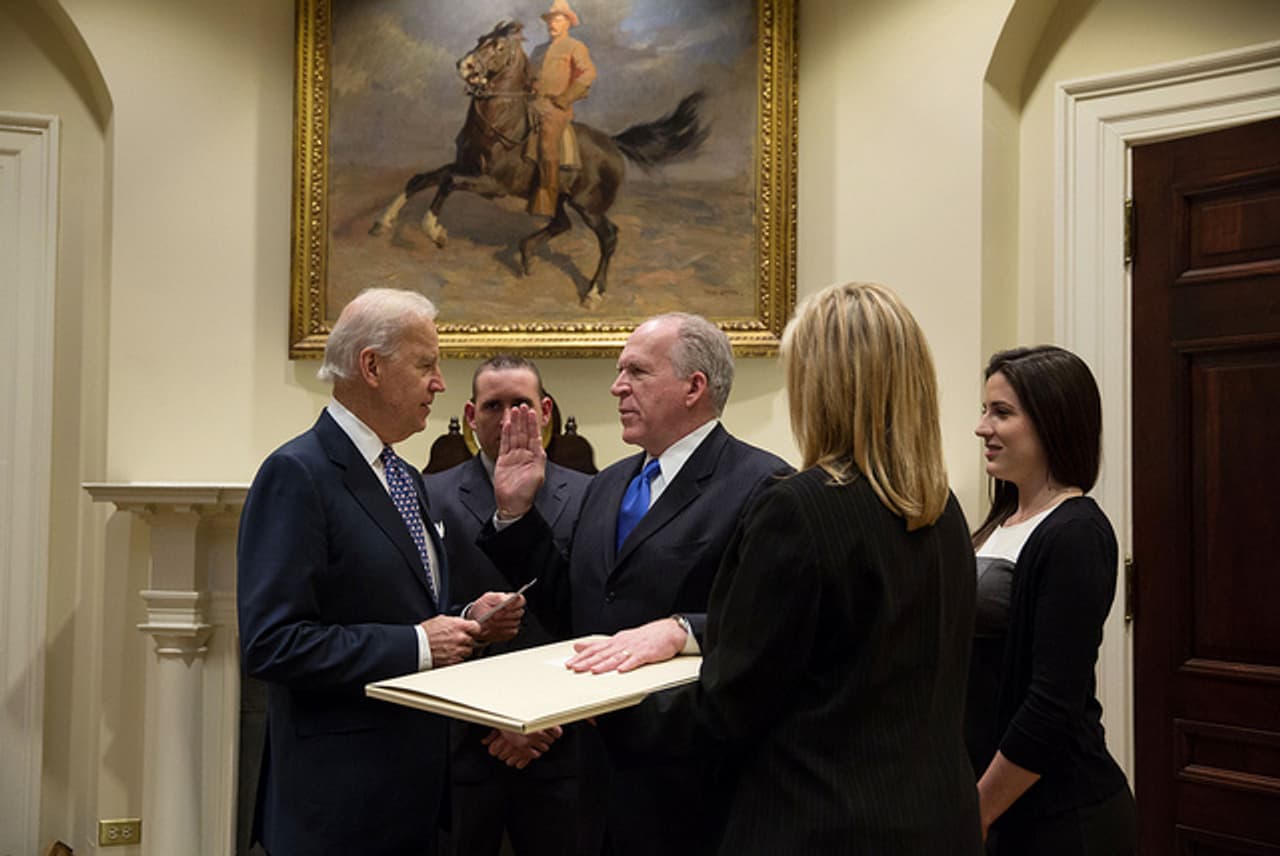
Secret US documents show Brennan’s ‘no civilian drone deaths’ claim was false
John Brennan being sworn in as CIA director in March 2013. (White House/ David Lienemann)
US intelligence officials were aware that at least one civilian had died in drone strikes in Pakistan during 2011, despite claims to the contrary made by the man now running the Central Intelligence Agency.
In June 2011, John Brennan, at the time President Obama’s chief counter terrorism adviser, stated publicly that for ‘almost a year’ no civilian had died in US drone strikes in Pakistan.
But leaked US intelligence documents obtained by news agency McClatchy show this was not true.
According to national security reporter Jonathan Landry, the intelligence documents, which chronicle the drone war in Pakistan, admit to a civilian death on April 22 2011 – two months prior to Brennan’s public claim.
At the time of the strike, an anonymous US official had insisted to CNN that ‘there is no evidence to support that claim [of civilian casualties] whatsoever.’
The April 22 drone strike hit a house before dawn, killing at least 25 people in North Waziristan. Seven media organisations reported that at least five civilians died, including three children. Both Associated Press and the Bureau sent investigators into the field. Each confirmed that civilians, including women and children, were killed in the attack.
‘Highly sensitive’
The McClatchy investigation involves the most significant leak so far of US intelligence documents covering the CIA’s Pakistan drone war.
The documents, which have not yet been published, are said to cover two periods: 2006 to 2008, and January 2010 to September 2011.
Reporting on the leaked papers indicate that what US officials say publicly about drone strikes does not always match their private records.
Throughout the first half of 2011 US intelligence sources had been insisting that civilians were no longer being killed by drone attacks. On June 29 2011 Brennan said ‘there hasn’t been a single collateral [civilian] death‘ in Pakistan in 10 months.
The Bureau was the first to challenge this assertion. After carrying out a field investigation in Pakistan’s tribal areas, it submitted to the US administration a list of 45 civilians killed in drone strikes in the period Brennan had referred to. A senior US counter terrorism official refuted the findings at the time, insisting: ‘The most accurate information on counter-terror operations resides with the United States.’
None of these civilian deaths seem to be reflected in the US records obtained by McClatchy, including dozens killed in a strike in March 2011.
‘Forced approval’
According to the news agency the documents also show that cooperation between Pakistan’s intelligence service the ISI and the CIA went far deeper than previously understood.
From 2006 to mid-way through 2008 the CIA sought approval for strikes from its Pakistani counterpart, according to the reports. In 2006, for example, the CIA asked permission to carry out seven strikes, with the ISI agreeing to five. It is not known if all of these took place.
The documents, if published in full, could prove important to the public’s understanding of the covert drone war. The Bureau’s data for example only records three US attacks for 2006, with New America Foundation, which also records drone strikes, listing two.
The documents reveal the US was also sometimes the beneficiary of negotiations. On at least two occasions the ISI gave its ‘forced approval’ for CIA attacks, having ‘relented under CIA cajoling’ according to the US news agency.
And the documents report at least one previously unrecorded drone strike. The ISI asked the US to target an ‘insurgent training camp’ in North Waziristan on May 22 2007. An assault by the Pakistani army on the camp had failed and the ISI called for drones, despite having been told the Agency’s Predators would not be used to support Pakistani combat operations, according to McClatchy.
‘The extended Haqqani family’
Other civilian deaths are reported in the leaked documents – although these happened under President Bush. On September 5 2008 the US targeted a house belonging to Jalaluddin Haqqani, patriarch of the Haqqani Network.
Despite only declaring the Haqqani Network a terrorist group in 2012, the leaked records show that the CIA targeted the leader’s home four years earlier. And the documents confirm that Haqqani women and children were killed in the strike.
Another secret US intelligence report obtained by Dawn in 2009 also noted that the CIA knew ‘members of the extended Haqqani family were killed’ in the September 2008 attack.
The McClatchy investigation reveals other differences between US officials’ public statements and private records. In September 2012 President Obama told CNN that drone strikes can only be launched when there is a ‘serious and not speculative’ threat.
He added that drones could only be used in a situation ‘in which we can’t capture the individual before they move forward on some sort of operational plot against the United States’.
But the leaked documents indicate that far from targeting senior al Qaeda militants intent on attacking the US, they have killed vaguely identified Afghan, Pakistani or ‘unknown’ militants.


